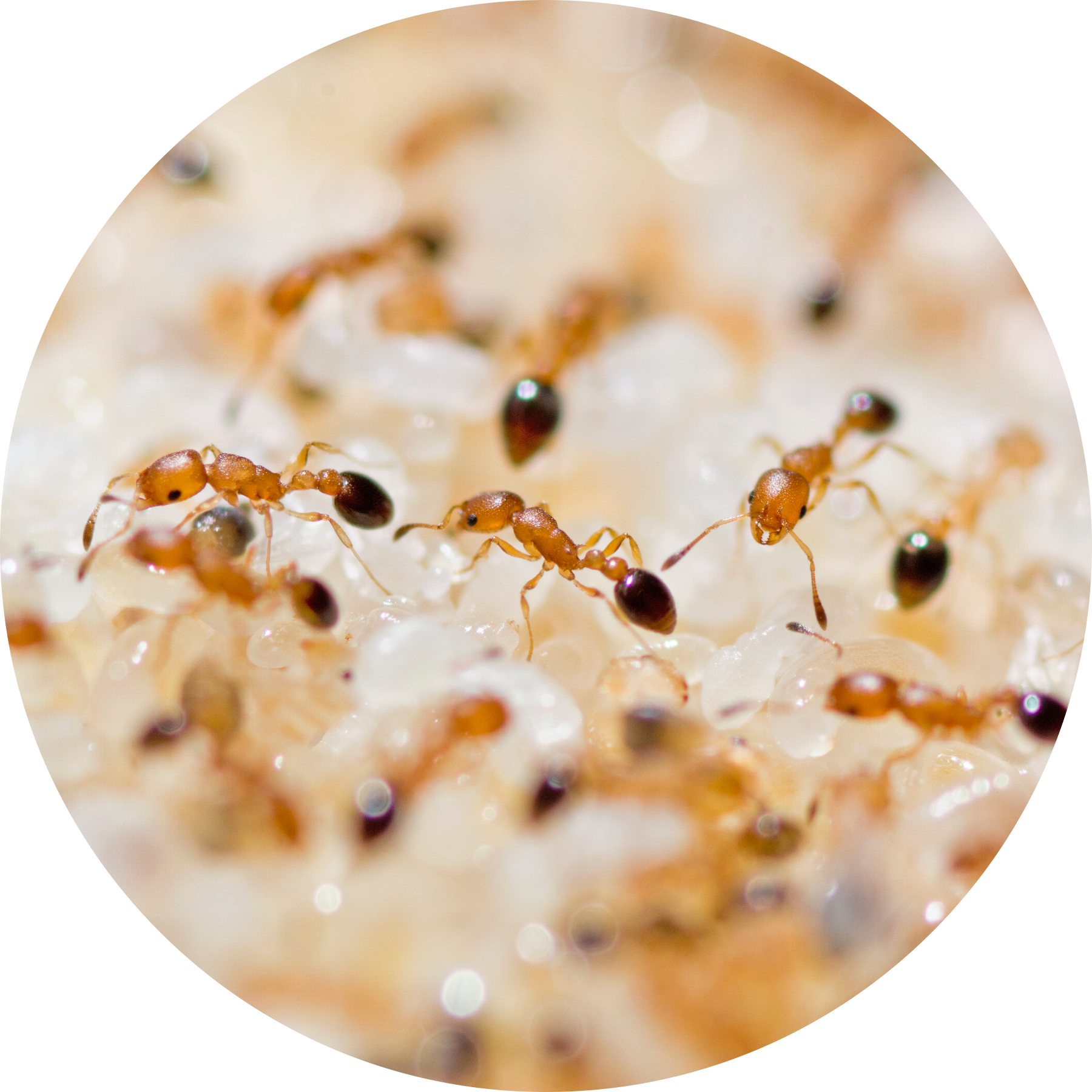Welcome to the Insect Evolutionary Genomics lab at the University of Münster!
Our work primarily aims at understanding the function and evolution of genomic complexity, currently focusing on advancing our understanding of how structural and compositional differences between genomes arise, how these differences become evident at the phenotypic level, and how selection and drift eventually produce evolutionary change. For this, we study genome evolutionary mechanisms at the level of species, populations and families to get a complete picture of the molecular and genetic mechanisms that allow adaptive evolution and differentiation at the level of the genome.
We approach these mechanisms from two different directions.
We either begin from an organismal perspective, focusing on adaptive traits that emerged within a group of populations or species – for example the convergent evolution of inquiline social parasitism in fungus-growing ants. To unravel the underlying evolutionary processes, we then study phenotypic (e.g. behavioral, morphological, transcriptomic) and genetic/genomic changes underlying the adaptive change. Eventually, we aim to develop model based on our understanding of genome evolutionary and population genetic mechanisms that explain how the adaptation could arise and be favored by selection.
Alternatively, we study evolutionary mechanisms in a suitable system, so far focusing on mechanisms of rapid adaptive change, e.g. via transposable elements (TEs), phenotypic plasticity and epigenetic inheritance, or genome rearrangements. The latter approach usually involves the selection of suitable model organisms that can be kept under laboratory conditions over several generations (i.e. the ant Cardiocondyla obscurior and the parasitoid was Aphidius ervi).
Our toolkit is clearly biased towards big data analyses, in particular approaches from the fields of comparative genomics, population genomics, and transcriptomics. However, our projects commonly also involve field work (either for sample collection or to study the organism) and behavioral or molecular experiments in the laboratory to support findings from big data analyses.
Most of our research has so far focused on ants, while only a minority of my ongoing projects and collaborations focus on honey bees and parasitoid wasps. We study species so rare that they are almost impossible to collect and study under laboratory conditions (inquiline social parasites in Acromyrmex) or species that are very well suited to be kept under artificial conditions in large laboratory populations (e.g. C. obscurior and A. ervi).

21.10.2025
The paper on HSP90 in Tribolium with Simo and
Lukas is
published
in Nature Communications now!
04.09.2025
After over 10 years of work, we have published the
first paper on the GAGA project. Read it
here.
04.09.2025
Simo and Lukas joined Wei and others in a paper on
fatty acid synthase genes in Nasonia. See the preprint
here.
02.09.2025
Nanda Vo gracefully defended his Master’s thesis
on transcriptomic signatures of plastic adaptation in Aphidius
parasitoids. Congrats! 🎉
22.08.2025
Our study on adaptive evolution in ant odorant
receptors is
online
as a preprint!
31.03.2025
Another long-lasting project coming to an end with
contributions from Simo and Lukas!
This is
on HSP90 in flour beetles.
15.03.2025
Tania’s paper with contributions by Simo, Janina
and I is out on
bioarxv.
12.01.2025
Janina just posted her preprint on horizontal gene
transfers in ants. This is a great paper, really! See
here.
16.12.2024
>10 years of work in one paper. The
preprint
for the Global Ant Genomics Alliance is online!
19.08.2024
Isabell delivered a great defense of for her
Bachelor’s degree today! 🎉
16.08.2024
Josh defended his Master’s thesis on molecular
decanalization in Cardiocondyla. Congrats, Josh! 🎉
13.07.2024
There is a new
paper on Transposon Displays in Cardiocondyla. Beautiful work
by Esther! 🙌
13.05.2024
Simo is on a roll. Another paper accepted,
this
time in BMC Biology! We explored the evolutionary genomics of social
polymorphisms in Pogonomyrmex californicus. 🙌
30.05.2024
Simo’s paper on recombination rate dynamics in
Cardiocondyla obscurior was accepted in Genome Research. Check it
out here!
🙌
11.04.2024
Nanda has started his Master’s thesis on the
molecular signatures of host adaptation in Aphidius ervi. 👋
18.12.2023
Sandra defended her Master’s thesis on olfactory
system evolution in ants. She will move on to do a PhD in Jena.
Congrats! 🎉
13.05.2022
Janina defended her Master’s thesis on horizontal
gene transfers in ants and will continue as a PhD student. Congrats, and
welcome! 🎉👋
08.04.2022
Esther defended her Master’s thesis on phenotypic
robustness, TEs and heatshocks in Cardiocondyla. Eshter will stay
on as a PhD student. Congrats, and welcome! 🎉👋
28.01.2022
Our website has gone online. Check out our team and an overview of all published papers.
05.01.2022
The DFG-funded project on “Transposable elements
as genetic innovators in the invasive ant Cardiocondyla
obscurior” will start soon!
Copyright © 2021 Lukas Schrader